Qualcomm Intros Snapdragon X Plus, Details Complete Snapdragon X Launch Day Chip Stack
by Ryan Smith on April 24, 2024 9:15 AM ESTSnapdragon X Plus: Second Verse, A Bit Less Than the First
Alongside today’s announcement of the Snapdragon X chip SKUs and the Snapdragon X Plus branding, Qualcomm put together a short presentation on the Snapdragon X Plus. Given that the underlying hardware is identical to the Snapdragon X Elite, there’s not much to talk about here in terms of technology or technical specs.
But ahead of the mid-year hardware launch, Qualcomm is providing some fresh performance slides, comparing the Snapdragon X Plus to its current-generation competition from Intel and AMD, as well as Qualcomm’s own Snapdragon X Elite. As with all vendor-provided benchmarks, these should be taken with a grain of salt. But if nothing else, it’s notable here what Qualcomm is and isn’t saying.
With 10 high-IPC CPU cores, Qualcomm should fare well in multi-threaded workloads, and this is exactly what they’re opting to promote. According to the company, the Snapdragon X Plus has a significant edge in both performance and power consumption at iso-power and iso-performance respectively. In the case of Cinebench 2024MT, that’s a 28% performance advantage over the Core Ultra 7 155H, or matching that chip’s peak performance at 39% lower power consumption.
Notably, however, what you won’t find from Qualcomm is any material promoting Snapdragon X Plus’s single-threaded performance versus any competition. With those peak clockspeeds of 3.4GHz, the Plus isn’t in a very favorable position versus the 4.8GHz Core Ultra 7 155H, even with what is presumably an IPC advantage.
As far as Qualcomm’s own chips are concerned, the Elite understandably has the advantage at any point on the curve in these MT tests. For a given architecture, a larger number of CPU cores is always the more energy efficient options, never mind the Elite’s clockspeed advantage on top of that. In any case, Qualcomm’s own figures put the Plus at about 15% behind the flagship Elite in Geekbench, and around 20% behind in Cinebench.
The company is also touting an advantage in GPU performance. Though as the benchmark in question is 3DMark Wildlife Extreme, a bencehmark that Qualcomm has already optimized for forwards, backwards, and upside-down within their drivers, I’m more interested in seeing how more PC-exclusive workloads perform. Though to Qualcomm’s credit, they’re no stranger to that space either, as they’ve been shipping Windows-on-Arm Snapdragon SoCs for several years now.
Snapdragon X Plus: Live and In Person
Finally, alongside briefing the press on the Snapdragon X Plus, Qualcomm also had some devices using the new chip SKU to show off, demonstrating the performance of the chip. This setup was similar to Qualcomm’s Snapdragon Summit preview event for the Snapdragon X Elite in October, albeit a bit more free-wheeling and hands-on now that the hardware is a bit more mature and there’s less of a chance of something going awry.
As with that preview event, Qualcomm has equipped their own internal reference design laptops with the chips. With its lower performance, all of the Snapdragon X Plus systems were the “config B” system, which is Qualcomm’s thin-and-light reference design, sporting a 14.5-inch OLED screen and designed for a total system TDP of 23 Watts.
| Qualcomm Snapdragon X Reference Test Systems (Thin and Light) | ||
| AnandTech | Snapdragon X Elite (X1E-80-100) |
Snapdragon X Plus (X1P-65-100) |
| 2 Core Max Turbo | 4.0GHz | 3.4GHz |
| All Core Max Turbo | 12C @ 3.4GHz | 10C @ 3.4GHz |
| GPU | 3.8 TFLOPS | 3.8 TFLOPS |
| RAM | LPDDR5X-8448 | LPDDR5X-8448 |
| Display | 14.5-inch OLED 2880x1800 |
14.5-inch OLED 2880x1800 |
| Thickness | 15mm | 15mm |
| Device TDP | 23W | 23W |
| Cooling | Active | Active |
| Battery | 58Wh | 58Wh |
The Elite version of this laptop was running the X1E-80-100 chip (the same chip as last time) which features a reduced performance GPU, a peak dual-core CPU clockspeed of 4.0GHz, and an all-core turbo of 3.4GHz. Meanwhile the Plus system has an identical GPU and all-core turbo clockspeed, but only 10 CPU cores with a peak dual-core CPU clockspeed of 3.4GHz.
As before, these systems were pre-configured with major benchmarks selected by Qualcomm, including Geekbench 6.2, Cinebench 2024, UL Proycon, PCMark 10, 3DMark, Blender, and new-to-Windows-on-Arm, Chrome. Qualcomm did let us touch these machines this time around, but these demos are still primarily being hosted to prove that Qualcomm is achieving the performance figures they claim.
On that note, here’s a quick rundown of Qualcomm’s performance claims, and what we observed for the Plus in action.
| Qualcomm Snapdragon X Benchmark Scores (Thin and Light) | ||||
| AnandTech | Elite - QC Expected Range | Plus - Observed | Plus - QC Expected Range | Plus vs Elite Performance |
| Cinebench 2024 ST | 121-123 | 109 | 107-109 | 89% |
| Cinebench 2024 MT | 920-980 | 860 | 825-845 | 86% |
| Geekbench 6.2 ST | 2750-2800 | 2420 | 2400-2425 | 87% |
| Geekbench 6.2 MT | 14200-14400 | 13049 | 12800-13100 | 91% |
| Chrome - Speedometer 2.1 | 450-470 | 426 | 410-430 | 91% |
| Chrome - JetStream 2.1 | 310-320 | N/A | 280-290 | 91% |
| PCMark 10 Applications | 12800-13200 | N/A | 12500-12800 | 97% |
| UL Procyon - Office Productivity | 6200-6500 | N/A | 5700-5900 | 91% |
| UL Procyon - AI CV Inference | 1750-1800 | N/A | 1750-1800 | 100% |
| 3DMark Wildlife Extreme | 37.1-38.5 fps | 37.1 | 37.1-38.5 fps | 100% |
| Blender (CPU) | 380-410 | N/A | 340-360 | 88% |
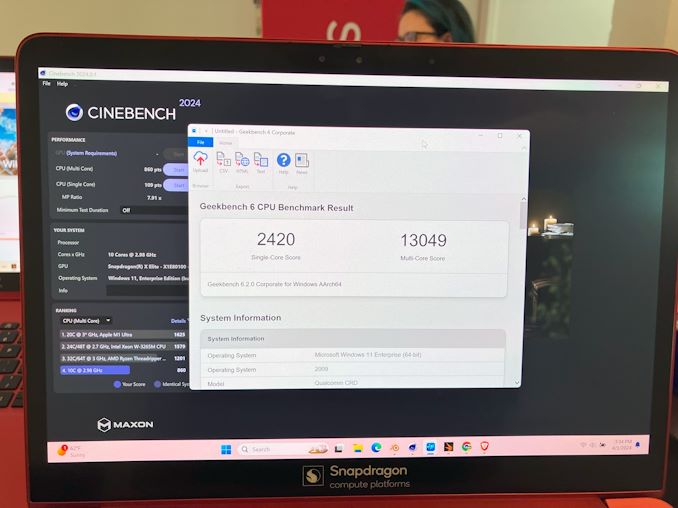
Geekbench 6.2 & Cinebench 2024
And with a little hands-on time, I even convinced Qualcomm’s representative to run the newer Speedometer 3.0 test on Chrome, which has just come out and was not yet part of their official benchmark suite. It scored 22.8.
Notably, here, the Snapdragon X Plus is closer in performance than what clockspeeds alone would predict. In Qualcomm’s supplied benchmark results, the Plus is never more than 14% behind in multithreaded workloads, and 13% behind in single-threaded workloads. And most of the time, it’s a 10% difference or less.
The 23 Watt system-wide TDP limit of the Qualcomm reference system is relatively constraining, all things considered. So I would not be the least bit surprised if the Snapdragon X Elite is being held back, in part, by not being able to run faster within Qualcomm’s systems. In other words, this is a more real-world test, as opposed to testing peak-to-peak unbounded by TDP concerns.
Overall, I don’t know if anything presented with the Snapdragon X Plus thus far would be considered all that surprising. With Qualcomm making their biggest push into the PC market yet, it makes perfect sense that they’re introducing multiple SKUs – and that they’d need some kind of branding to differentiate them. And while the Plus obviously won’t deliver the kind of chart-topping highs that the Elite will, it’s still based on all the same hardware that Qualcomm is banking on to make their reset PC ambitions a success. So like the rest of the Snapdragon X family, I’m looking forward to seeing what the hardware – Oryon CPU cores and all – can deliver when it launches in the middle of this year.


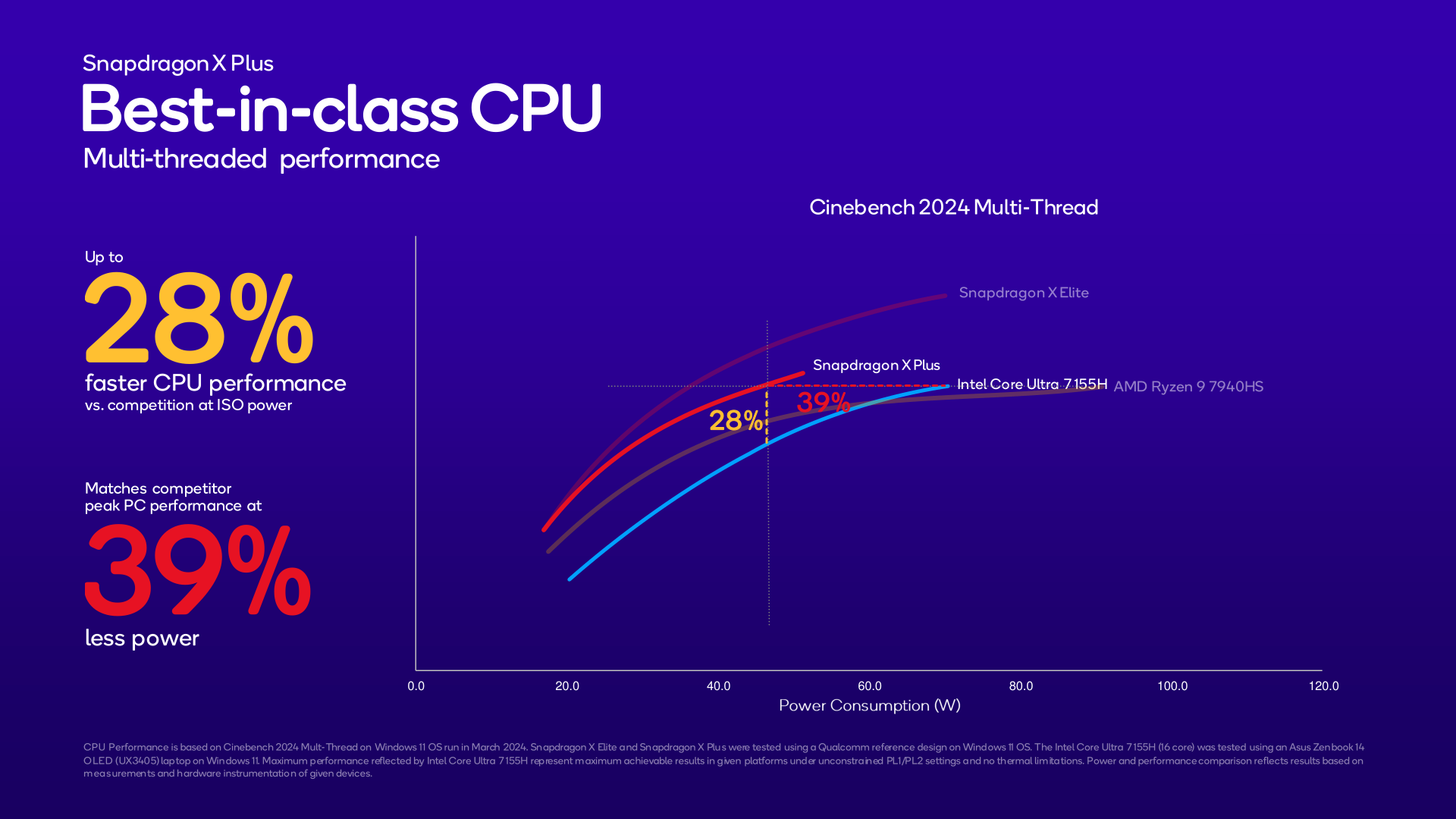
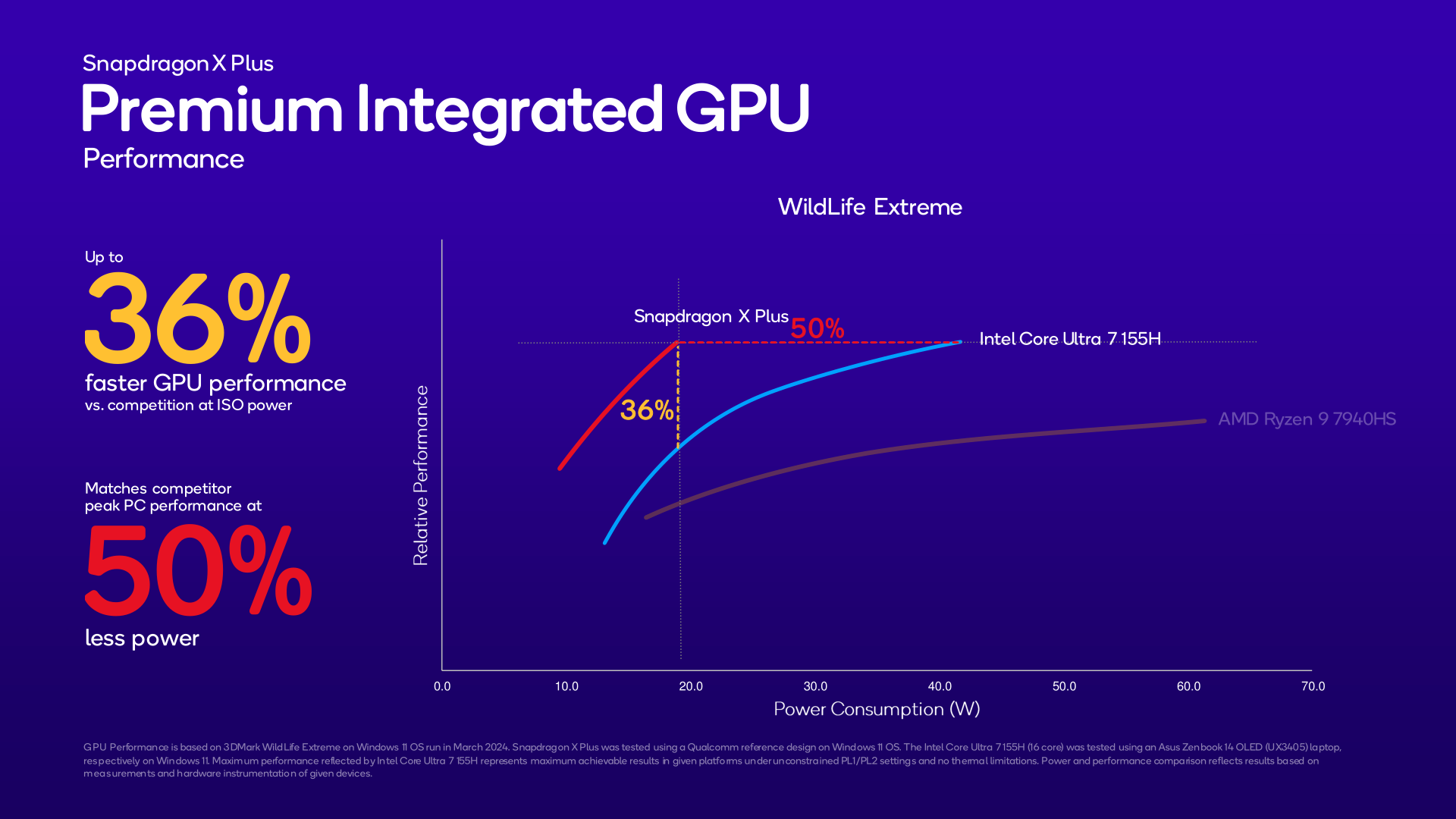







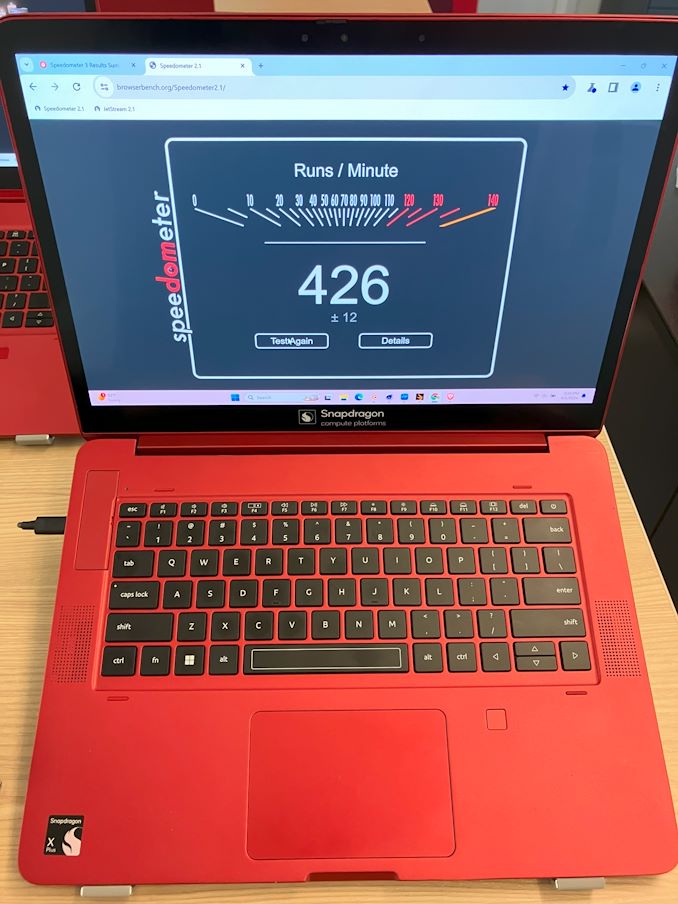

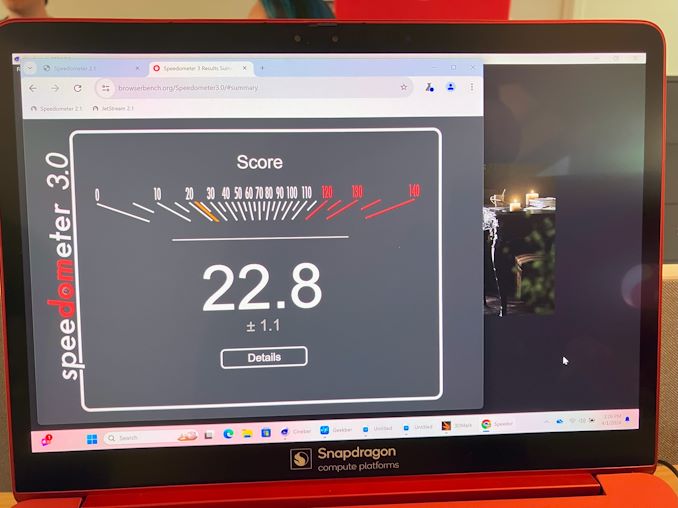









50 Comments
View All Comments
digiguy - Saturday, April 27, 2024 - link
there are tons of ultrabook users who don't game or do any rendering Replyfelixbrault - Thursday, April 25, 2024 - link
Abysmal single-thread performance confirmed. In speedometer 3.0 (mostly single threaded performance) my Iphone 14 Pro max get 25.2 of score. Replylmcd - Thursday, April 25, 2024 - link
Qualcomm's ego and desire to be seen as a direct Intel/Apple competitor is wasting a perfectly viable core. This should be an Alder Lake-N competitor. It could easily win the sub-$500 market and the education market with half the core count on TSMC 6nm. Replynandnandnand - Friday, April 26, 2024 - link
If we believe Qualc, It's competitive with Phoenix and Meteor Lake, if not Strix Point (other than the big boy 45 TOPS NPU).If you want cheap Windows on ARM, MediaTek has to come to the rescue. ARM's CEO said the exclusivity deal is ending this year. Reply
meacupla - Friday, April 26, 2024 - link
Mediatek mid and low range are cheap, but their top end is pricey.The only phones I could find have comparable prices between Mediatek Dimensity 9300 and Snapdragon 8 Gen3. Reply
eastcoast_pete - Thursday, April 25, 2024 - link
Would love to hear any comments from Qualcomm about this article in Semiaccurate https://www.semiaccurate.com/2024/04/24/qualcomm-i...If there's anything to that story, Qualcomm will have some explaining to do. This doesn't look good, and they better get out in front of this now! Reply
Ryan Smith - Friday, April 26, 2024 - link
"Would love to hear any comments from Qualcomm about this article in Semiaccurate "Qualcomm's official response is as follows:
"We stand behind our performance claims and are excited for consumers to get their hands on Snapdragon X Elite and X Plus devices soon.” Reply
eastcoast_pete - Friday, April 26, 2024 - link
Thanks Ryan! Well, at least Qualcomm is consistent, even if it's consistent in deflecting criticism. I hope they realize that it's in their own best interest to get even pre-production laptops in the hands of outside reviewers like yourself ASAP. ReplyHarry_Wild - Monday, April 29, 2024 - link
If Qualcomm can release a perfect low wattage CPU that makes a Windows based fanless laptop like that of the Apple’s MacBook Air M3: I will buy it! Replyeastcoast_pete - Monday, April 29, 2024 - link
Geekbench just posted results for a Dell Inspiron with a Snapdragon X Elite SoC; they are considerably lower than the figures QC showed https://browser.geekbench.com/v6/cpu/5889224. Of course, both Windows on ARM and the firmware used are likely still not ready to ship releases, but then, what is QC running on their samples that got much better numbers, and why didn't Dell (a Tier 1 OEM) have access to those? QC isn't helping their case here. Reply